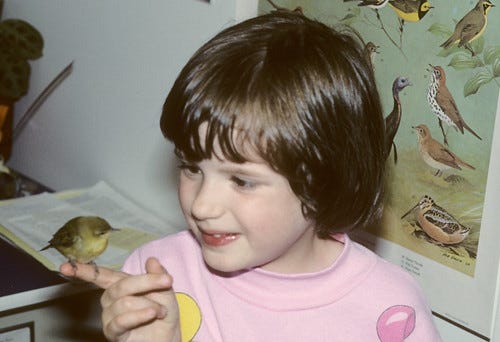How Night-Migrating Birds Avoid Collisions
It was easier before artificial lighting entered the scene.
(Listen to the radio version here. The nocturnal Swainson’s Thrush calls were recorded by Bill Evans.)
For the past week or so, radar has been showing millions of migrating birds aloft in the skies just about every night.

On the heaviest migration nights, way more birds are flying somewhere above Interstate-35 than cars are driving on it. I couldn’t get any kind of good estimate of how many vehicles travel on I-35 each day, but a very busy stretch—that running through Texas—gets somewhere in the neighborhood of 165,000 vehicles per day, and that stretch is almost a third of the highway’s entire 1,568-mile length.
Parents of teenagers often feel panicky when their child is starting to drive, especially on interstates. Entering and exiting, safely changing lanes, dealing with aggressive drivers, and the huge size discrepancy between a subcompact and SUVs, much less modern semis—it’s scary!
We humans have designed our interstate highways with well-marked lanes, no-passing zones, and other safety features, and modern cars have a lot of built-in safety features–headlights, brake lights, turn signals, horns, seat belts, airbags—my outside mirrors have a signal if a vehicle is in my blind spot, and my car makes all kinds of noises if I cross a lane marking, take my hands off the wheel, or even if I’m backing out of a parking lot space when another vehicle might be coming. Traveling birds may not have thick metal surrounding their fragile bodies, or at least a good motorcycle helmet, but they do have plenty of built-in features that have kept them safe during migration for tens of thousands of years.
As with a driver entering the freeway, the first step for a nocturnal migrant bird is to get into the flying lanes while not hitting any obstructions. That’s not too hard when it’s still dusk, but if a bird is perched in a tree on a dark night, I think it must look for a patch of stars or, better yet, the moon through an opening in the branches—then it knows it can safely fly through.
I believe the moon and patches of stars must be important because, when I was a rehabber, I often cared for warblers during fall migration.
When I left them all night in my tiny home office, which was as dark as a photography darkroom, they’d spend the whole night rooted in the same spot—I could tell by how many droppings had accumulated beneath their perches overnight—unless I happened to enter the room and turn on the ceiling light. At that moment, any warblers in the room would instantly fly straight up into the light fixture. How were they supposed to know that there could be such a bright white round thing that wasn’t 238,855 miles away?
The room was tiny and the birds weren’t flying fast enough to injure themselves, but I only did that a couple of times before I learned my lesson—if I needed to go into the room at nighttime, I’d hold a dim flashlight against my hand so only a bit of light seeped out the edges. But this suggests that when birds are dealing with fog and low ceilings, seeing a light ahead almost definitely seems to them an assurance that there’ll be clear sailing if they fly toward the light, which, in the natural world, there would be.
Once birds have cleared the immediate obstructions, they rise to an altitude well above natural obstructions. We know that birds respond to changes in barometric pressure, but are still teasing out exactly how they sense it. Their built-in altimeter/barometer almost certainly involves both the system of air sacs filling much of their body cavity and their paratympanic organ—a sensory organ found exclusively in the inner ear of birds and a few other non-mammalian animals. Tiny hair cells within the paratympanic membrane respond to changes in air pressure.
How high is a nocturnal migrant’s cruising altitude? Studies by BirdCast, a partnership between the Cornell Lab of Ornithology, Colorado State University, and University of Massachusetts Amherst, analyzed radar to establish that in the eastern United States, birds migrate at about 1,300 to 1,600 feet while birds in the West average about 2,600 feet and some reach 5,000 to 6,000 feet in altitude—over a mile high. The mountainous terrain of the West provides obstructions far higher up than in the East.
However they reach cruising altitude, it’s not quite clear sailing because plenty of other birds are flying up there, too. How do they avoid collisions with one another? Nocturnal migrants make characteristic calls as they fly along, signaling their locations to one another.
With sudden changes in weather, or when birds simply get tired and want to head back to earth, they must find safe places to land. On moonlit nights or if they keep going until first light, this is probably not too hard. In sudden downpours, low cloud ceilings, or foggy conditions, it can be trickier, but birds have clearly evolved to deal with this. At least in the natural world.
Tragically, we humans have made takeoffs and landings much more dangerous thanks to artificial lights in their air space—on communications towers, lighthouses, and high-rise buildings. Those of us who negotiate freeway driving trust car manufacturers and highway engineers to make the process as safe as possible. Who can birds trust to protect them?





